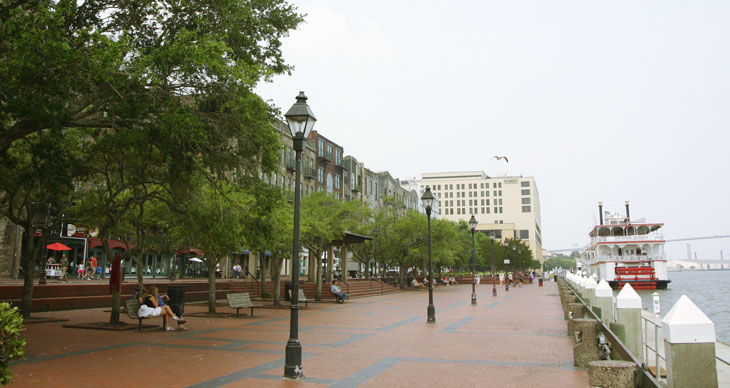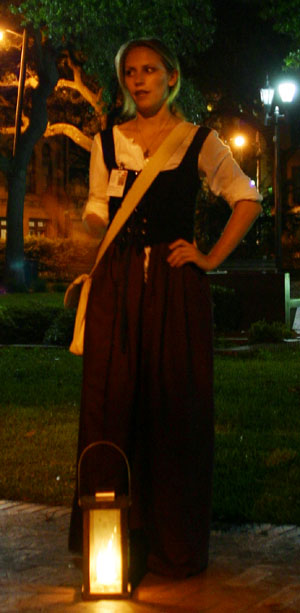
Two posts about the trip, and we’ve only covered one day, but now we’ll step up the pace a little bit. Naturally enough, when visiting the Savannah, Georgia area, we tooled around in historic downtown Savannah. I’m not much for chasing historic areas and visiting old buildings, and I don’t do the tourist thing too often, so if you’re looking for a comprehensive travelogue telling you all about the city, you need to be looking elsewhere (I imagine you can find a travel blog or two someplace.) But there were still some things that struck me about the place.
 I currently live in a town that has some historic sections of its own, but this is night and day in comparison with Savannah. We have a couple of older buildings and cemeteries (one of which is almost completely trashed,) but that’s about it. Savannah was a more prosperous city, being a trading riverport, and maintained this level of income to this day, so an astounding number of the buildings downtown are in great condition and date to colonial times. They also realized that this was a tourist draw, and so keeping or restoring the buildings is an investment. While modern life takes place in the heart of the city, it often does so in classic structures. They have also maintained some of the original roads down to the riverfront, and many of the iron gaslights. In fact, ironwork abounds in the city, and my speculation is that this was a status symbol of the time, the colonial equivalent of a Lamborghini. The well-to-do flaunted their success with iron facings, accents, gates and lamps, much of which remains today.
I currently live in a town that has some historic sections of its own, but this is night and day in comparison with Savannah. We have a couple of older buildings and cemeteries (one of which is almost completely trashed,) but that’s about it. Savannah was a more prosperous city, being a trading riverport, and maintained this level of income to this day, so an astounding number of the buildings downtown are in great condition and date to colonial times. They also realized that this was a tourist draw, and so keeping or restoring the buildings is an investment. While modern life takes place in the heart of the city, it often does so in classic structures. They have also maintained some of the original roads down to the riverfront, and many of the iron gaslights. In fact, ironwork abounds in the city, and my speculation is that this was a status symbol of the time, the colonial equivalent of a Lamborghini. The well-to-do flaunted their success with iron facings, accents, gates and lamps, much of which remains today.
The main road through the city, separated from the river by only one row of buildings, sits roughly two stories higher than the river, so you have to actually descend sharply to remain at “groundlevel,” and in many places this is by original stairs and alleys. We take for granted the building codes that make stairs uniform in height and angle, and this becomes remarkably clear when you take a flight built before this standardization and try not to fall ass over tip. Choosing the original roads is virtually no better, since they’re paved with large round ballast stone – you understand that “cobble” and “hobble” probably are related words as you attempt not to twist an ankle. Yes, they do provide safer access down to the river, but that’s for weenies.
We opted for a trolley tour, which has its merits. While open and not air-conditioned, something that is quite noticeable this time of year, the driver provides plenty of details about the buildings and history while freeing you from the efforts of driving in downtown, and this is no small thing. On top of the fact that the streets are a little narrow and naturally busy, Savannah has this little trait created centuries ago, that of putting a park where a normal streetlight would be. So instead of a grid layout, imagine taking roughly every other crossroads and planting a square right at the center, then detouring the roads around this. You do not drive straight through this section, but spend a lot of time turning right, left, left, and right to get back to your original direction of travel. On the other hand, Savannah has more trees than any other city I’ve seen, and they are ancient, huge, and as mentioned, dripping with Spanish moss. Letting someone else drive is much better, and the trolley tours are such that you can disembark at various stops and rejoin a later trolley, getting a chance to walk around, eat, shop, and do all the touristy things. For our own part, this included rescuing a baby bird dangling from its nest in the City Market, which is the art gallery and café section of the town.
 Yes, of course I’m noticing the wildlife anyplace I go – you really didn’t expect else, did you? This applied to a couple of evenings later too, when we watched flying squirrels flashing from tree to tree in the twilight, too fast and unpredictable for me to capture on film (silicon, whatever.) We were downtown to catch an historic ghost tour, departing from the gates of the cemetery seen here. Tours are Savannah’s raison d’être it seems, and Savannah is considered the most haunted city in the US, so we couldn’t pass up a ghost tour – we’d already been by several of the haunted buildings on the trolley tour, but on a sunny day this doesn’t have the right atmosphere. So we selected a candlelit walking tour in the later evening.
Yes, of course I’m noticing the wildlife anyplace I go – you really didn’t expect else, did you? This applied to a couple of evenings later too, when we watched flying squirrels flashing from tree to tree in the twilight, too fast and unpredictable for me to capture on film (silicon, whatever.) We were downtown to catch an historic ghost tour, departing from the gates of the cemetery seen here. Tours are Savannah’s raison d’être it seems, and Savannah is considered the most haunted city in the US, so we couldn’t pass up a ghost tour – we’d already been by several of the haunted buildings on the trolley tour, but on a sunny day this doesn’t have the right atmosphere. So we selected a candlelit walking tour in the later evening.
If you’re at all familiar with this blog, you may be anticipating my dismissive, skeptical reaction, but believe it or not I was a good boy. As expected, these were simply accounts of what others had experienced in many locations around the town, and not statements about the existence of ghosts nor the attempt to experience them ourselves. I have no problem with good fun, and am not terribly concerned with whether someone is curious about the accounts and experiences – inquiry is just fine in my book, and in fact preferred. The caveat that I make is that it is reasoned inquiry, not committing to any presumed existence or lack thereof, but able to determine what decent evidence really is, and able to look for alternate explanations of phenomena rather than settling for something that seems “positive” and ignoring all else. Waving around an electro-magnetic field meter means absolutely nothing if you have no idea how often EMF occurs nor why ghosts in particular should emit or disturb them (hint: my computer monitor produces beaucoup EMF, as does any electrical device with decent amperage and low shielding.) And of course, photography is even worse, usually capturing far less light than our eyes can, and only occasionally modified to image spectra that we do not see ourselves, like near-infrared and ultraviolet. You did, of course, see the “ghost” in the cemetery photo here, on the grave markers themselves? You can see more here. I can assure you that we did not see any of these with our naked eyes, simply because they’re reflections inside the lens array of the cameras themselves.
 The tour itself was interesting, but not as dramatic as you might expect – other ghost tours and noisy buses going past don’t lend themselves to the right kind of atmosphere. We did not go into any of the haunted buildings – most of them are in regular use as inns or offices, and while some such tours undoubtedly exist, they’re also probably a lot more expensive. I amused myself by attempting several long existing-light exposures as we went along, sans tripod since I didn’t desire the encumbrance, so I braced where I could to try and reduce camera shake. In one such image, I discovered the secret of the historic ghost tour, seen here. I thought it meant it was a tour about historic ghosts, but our guide’s right arm seems to indicate that I was mistaken. Always check the fine print.
The tour itself was interesting, but not as dramatic as you might expect – other ghost tours and noisy buses going past don’t lend themselves to the right kind of atmosphere. We did not go into any of the haunted buildings – most of them are in regular use as inns or offices, and while some such tours undoubtedly exist, they’re also probably a lot more expensive. I amused myself by attempting several long existing-light exposures as we went along, sans tripod since I didn’t desire the encumbrance, so I braced where I could to try and reduce camera shake. In one such image, I discovered the secret of the historic ghost tour, seen here. I thought it meant it was a tour about historic ghosts, but our guide’s right arm seems to indicate that I was mistaken. Always check the fine print.
The empty sleeve effect even looks great at full resolution, and not half as fake as many feeble attempts at double exposures. If you’re wondering, it was merely catching (unintentionally I admit) our guide waving her arm during the 1/5 second exposure time, so that it blurred into indistinction – she otherwise held still enough to appear mostly sharp. I have plenty of other blurred photos, including one with a remarkably creepy effect from her facial movement, but since everything else is blurred it’s not half as interesting in appearance as this one.
The nature photographer part of us was not left behind at all, and later in the trip we got out to chase some critters. I’m not using the royal “we” in this case – The Girlfriend did no small amount of her own shooting, even though she doesn’t pursue it like I do. Now that my slides have returned from the lab, I’ll be sorting and scanning while I select some further post topics, and will be back shortly.




















































